The
Streets of Cebu
Named After:
|
|
|
|
|
|
|
|
|
| |
|
|
| |
"CELEBRATE LIFE, CELEBRATE CEBU!!!"
Cebu is a host to the well-known festivities celebrated all year round. These festivals reflect the customs and traditions of the proud Cebuanos and at the same time, promote tourism and uphold the culture that the Cebuanos came to live by.
Instruction for navigating the flash map
Click on a marked spot in the map to read about the festivals of Cebu. |
|
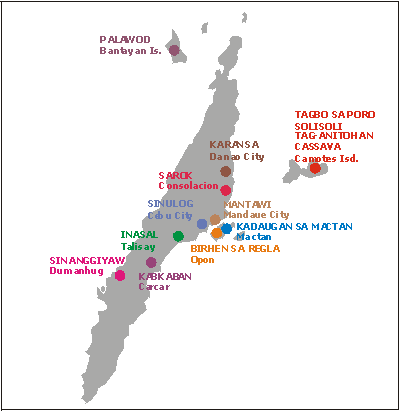
|
| |
| |
|
|
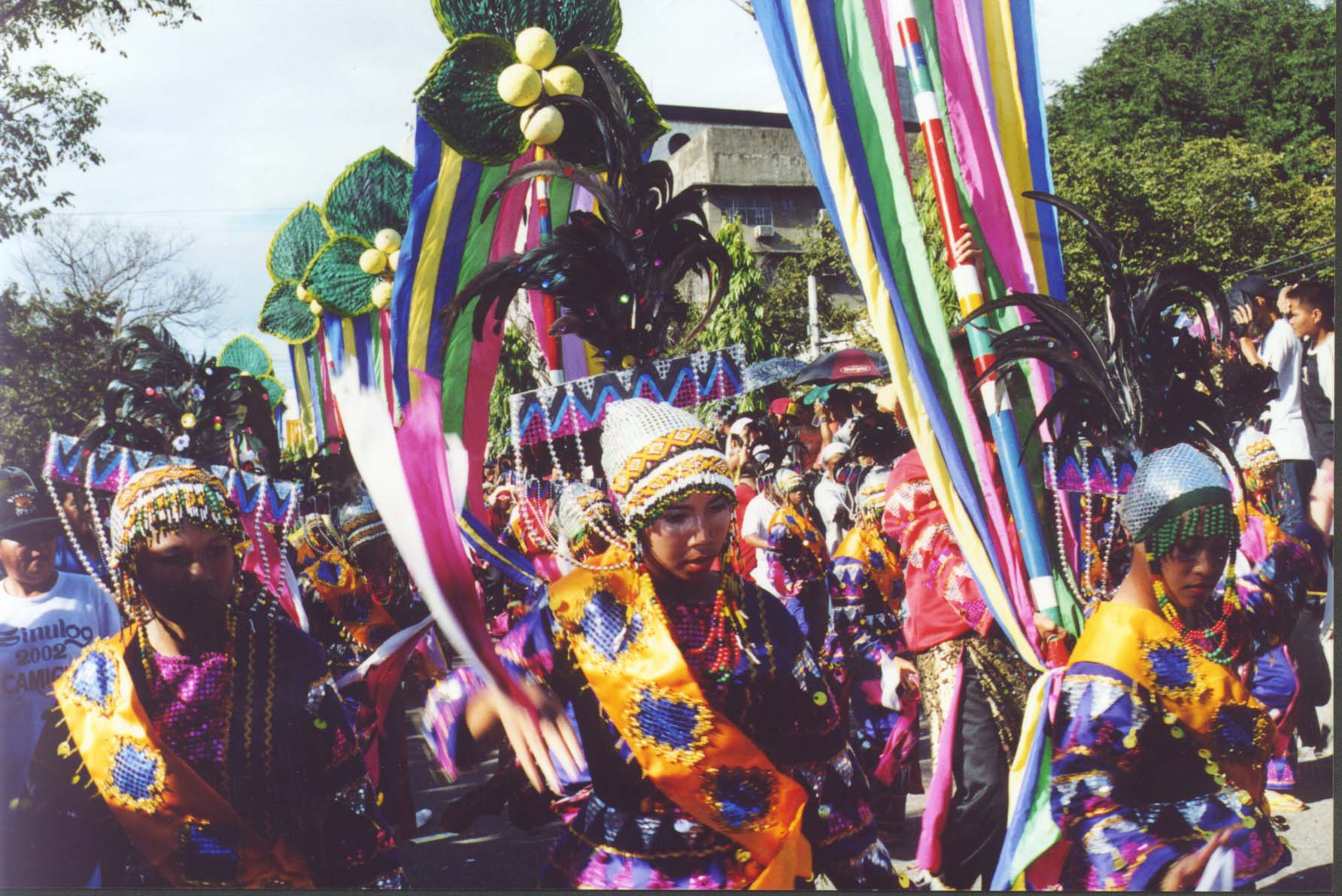 |
|
SINULOG FESTIVAL - Cebu City
The Sinulog festival is one of the grandest and most colorful festivals in the Philippines. The main festival is held each year on the third Sunday of January in Cebu City to honor the Santo Niño, or the child Jesus, who is the patron of the whole province of Cebu. The dance moves two steps forward and one step backward to the sound of the drums. This movement resembles the current, sulog in their dialect, of what was known as Cebu's Pahina River. Thus, it was called Sinulog by the Cebuanos.
Before the Portugese came to Cebu, the Cebuanos have already danced the Sinulog. When Magellan came , he brought with him Christianity and gave as a gift the image of the Sto. Niño to Queen Juana. Historians say that within the 44 years gap between the arrival of Magellan and Legaspi, the Sinulog was still danced by the Cebuanos but not as to honor their anitos anymore but to pay honor to Sto. Niño.
In 1980, Regional Director of MYSD (David S. Adilao) started the Sinulog Project, the sinulog dance became the pervading theme of the cultural celebration and has remained so to this day. The preparations for the Sinulog have spawned other activities which in themselves have become yearly events. An example of this is the putting up of decors on the facades of stores and buildings where the parade passes by and has become a symbol of the advent feast.
The different contingents for this festival wear colorful costumes and dances with the beat of the drums and gongs. During these times, the streets are filled with different stalls for business. Today, this celebration is used to attract tourists to Cebu City and raises their spirits high. The best contest of the finest and best Sinulog dancers are usually held at Cebu City Sports Complex.
|
|
|
|
|
|
|
|
SINANGGIYAW FESTIVAL - Dumangjug
The Sinanggi-yaw is indeed a festival of people using subjects namely, the planting and the thanksgiving. Only residents of Dumanjug may form a contingent indigenous material for costume, accessories, props and sets. There shall be no other musical instrument except those fast beats of the drums and bamboo.
The Sinanggi-yaw festival will surely become a show window for tourism development in Dumanjug. This becomes one o the major highlights that will happen during fiesta celebration. Folks from the province of Cebu and from other place in the country tart to look forward in seeing this unique and wonderful cultural festival every fiesta affair.
The festival is all set to happen every October 4 of the year showing their unending and valued efforts for setting aside some good ways in art, cultural and tourism development in the municipality of Dumanjug.
Mr. Danny Danopol, a Dumanjuganon - famed cultural trainer, stage director, designer, choreograph originally conceptualized this festival of merry-making and thanksgiving. it is the current executive secretary of the office of the mayor.
Finally, Sinanggi-yaw Festival is considered as a love project for the people of Dumanjug and for the province of Cebu. This will place, this placed, Dumanjug in the map of cultural development. and of course, this will boost the morale and dignity of the beloved Town of Golden Friendship, Dumanjug.
|
|
|
|
|
|
|
|
PALAWOD FESTIVAL - Bantayan
Are you Familiar with the word PALAWOD? Probably not, but its venue should ring a bell: Bantayan. For years, regarded as one of Cebu's best-kept secrets, the island is gradually finding its place among the Philippines' world-famous destinations.
Fishing is the main industry of Bantayan Island, and it is this that inspired Palawod, a festival celebrating the island's marine bounty. The word palawod means to go farther out to sea, (magpalaot in Tagalog), where fishermen go for the big haul. The festival takes place in Bantayan, the largest of the three towns and the center of trade, arts and culture. The date coincides with the feast of the town's patron saints, Peter and Paul, Christ's foremost fishers of men.
The festival had townsfolk dancing in the streets, a la Sinulog but garbed in marine motif such as shell skirts, giant clam headdresses; chipboard jellyfish and colorful bilaos made to look as carapace.
Palawod is Bantayan's contribution to the Cebu government's efforts to promote the island more aggressively as a key tourist attraction in northern Cebu, following improved communication and transportation links to the rest of the region and the country.
|
|
|
|
|
|
|
|
MANTAWI FESTIVAL - Mandaue City
The Mantawi Festial relives the historical past of the city, when it was first sighted by Magellan on April 7, 1521 at high noon, upon entry to the island Sugbo in search for food and supplies for its voyage back to Spain. Mandaue, a name derived from the legend of "mantawi" that was a vine growing abundantly in the cove, was mentioned by Antonio de Pigafetta as a flourishing settlement nearest Cebu, under the leadership of Datu Lambuzzan.
Thousands of energetic schoolchildren, both from the private and public schools, all dressed in colorful costumes, from Muslim-inspired attires to Maria Claras, from cheongsams to ternos and even bell-bottom pants of the '70s, made up the several contingents of street dancers meandering through the city streets projecting Mandaue's rich heritage, lifestyle and industry to the cadence of the Mantawi drumbeat. There are also transformations of native delicacies such as bibingka, budbud and tagaktak into dance movements, while broom and salt making are made alive in a street dance There are also huge diorama floats that likewise served as theater stages had some of the city's prominent citizens as actors and actresses reliving important historical events.
With this very victorious discovery, Mandaue has brought up those fascinating and intriguing tales from oral traditions into a very unique and colorful celebration- the Mantawi Festival
|
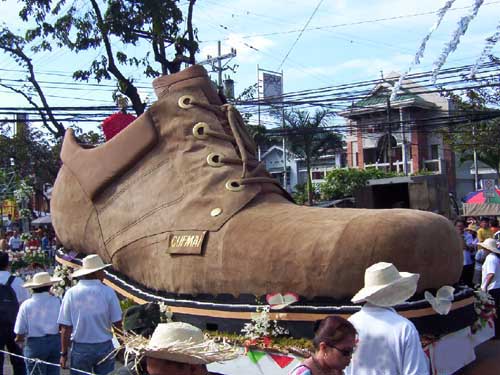 |
|
KABKABAN FESTIVAL - Carcar
In honor of Carcar’s patroness, St. Catherine of Alexandria, the town celebrates the Kabkaban Festival on November 24-25 with street dancing and other cultural heritage events.
The festival is derived from the root word, “kabkab”, the local name of a
tree-climbing fern that carpeted the branches of the acacia trees in the town. Kabkab is also the old name of Carcar before the place was Hispanized. The festival, held every third Sunday of November, will showcase Carcar's history, culture, and traditional products and industries-lechon (roasted pig), ampao (rice puff), bucarillos (sweets made from young coconut), takoy (sweet pomelo), and shoes and slippers-in a parade. The parade passes through the town's main street, historic Santa Catalina, lined with the heritage houses of its oldest and most prominent families. It ends at Carcar's Spanish colonial town plaza.
Carcar town is noted for its houses that are of Old Spanish style. During the fiestas, Carcaranons invite their relatives and friends and so with the town visitors into their homes to taste their popular local delicacies.
|
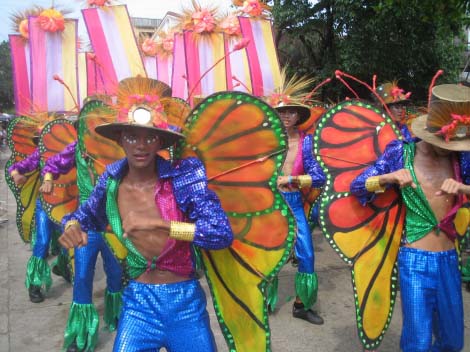 |
|
KARANSA FESTIVAL - Danao City
Karansa is a merry-making performed by local Danawanons whenever they group together durimg their idle times, especially after dinner. This is usually done by the barangay folks of Barangay Suba, one of the barangays in Danao City, who love music and dancing.
One time, a group of Danawanons mentioned of the Sinulog of Cebu, the Ati-atihan of Aklan, the Dinagyang of Iloilo, the Maskara of Bacolod, the Pintados of Tacloban and other ancestral and ritual dances and they decided to have their own way of street dancing which they named Karansa, a dance expressing one's joy and happiness performed in any body movement whenever someone feels the urge to dance whatever music there may be for as long as the steps jive with the rhythm of the music.
During the incumbency of Mayor Ramon D. Durano Jr., the Karansa was first performed as a street dancing and merry-making during the Danao City Fiesta Celebration. It has captured so much of the attention of the local Danawanons as well as the visitors so that it was then practiced anually as a tourist attraction.
In 1997, the Karansa Foundation was established with Mr. Jesus C. Mecca as the first elected President for the Karansa Foundation to have a legal personality and in order to have the support of the City government, the City Council of Danao enacted an ordinance declaring Karansa as one of the tourist attractions of Danao City. On October 06, 1998, the Karansa Foundation became an incorporation after having been registered with Securities and Exchange Commission.
As the official street dancing and merry-making of Danao, such as the Sinulog of Cebu, Karansa has no official beat yet as of the moment, however, the Foundation is in its search for the purpose.
|
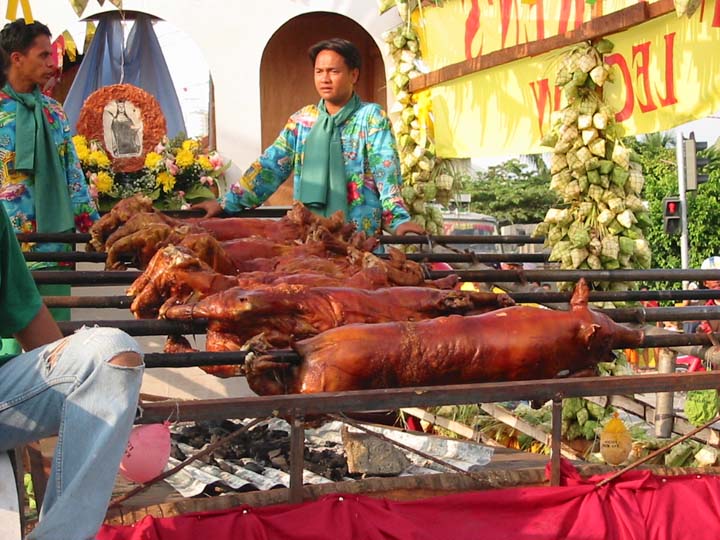 |
|
INASAL FESTIVAL - Talisay City
The City of Talisay thought of using the “inasal” as a symbol to promote it as a tourist destination. What better way to promote it than by having an “Inasal Festival” to coincide with the town fiesta on October 15, 2005. The local government, together with the various business enterprises and schools in Talisay, and in cooperation with the local “inasal maker”, has bonded to make this historical event a success.
The Talisay Official Government and the people of Talisay really hope to make this a yearly event in order to usher in local and foreign tourist all year around. The “inasal” festival was one of the highlights of Talisay city’s Halad festival last October 2005 in line with the celebration of the feast of St. Theresa de Avila, the city’s patron saint. That “inasal festival” was the first ever roast pig display held in the City and was attended by numerous people coming from different towns, provinces, and nations just to witness it and to taste the pride of the city. The success of the event was spearheaded by Talisay City Councilor Shirley Belleza who was also the chairperson of the City Council's committee of tourism development.
With this new celebration, people become more active which causes the success of the first ever Lechon Festival in the Region. The residents of the city slowly recognized the importance of patronizing the culture of tourism for it increases the businesses’ profits.
|
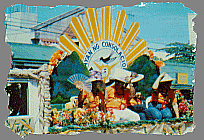 |
|
SAROK FESTIVAL - Consolacion
Sarok Festival is a mardi gras held every 14th day of February. This is to highlight the "Adlaw sa Consolacion" celebration. The dancers use "sarok" while dancing to the tune of Miligoy de Cebu, a song that originated in Consolacion.
The contingents of the festival are pupils and students from different elementary schools in Consolacion. They wear attractive costumes that fit for the kind of presentation of their choice. The sarok used as main props comes in various designs, which enhance one's sense of imagination. Presentations are judged according to performance, choreography and costume.
History tells that on January 6, 1998, the former Municipal Mayor, Hon. Maximo G. Malagar, called for a conference in presentation for the Founding Anniversary of Consolacion. Erlinda Napuli, the chair and the principal of Consolacion Central School at that time, solicited opinions regarding the activities. Cultural Affairs Coordinator, Mr. Rodrigo Apos, thought of a unique innovation, the SAROK FESTIVAL. He pointed out that if Cebu City has Sandugo Festival, Consolacion could also have a Mardi gras entitled Sarok Festival.
The term "sarok" comes from a kind of hat made of bamboo strips and dried banana leaves. Sarok making used to the main source of livelihood of the town folks especially these living in Barangay Tulotulo.
From then on, the Sarok festival has already become one of the most awaited celebrations of the year for the people of Consolacion. Moreover, the festival has been very successful every year and more people from the other parts of Cebu were encouraged to witness the very prestigious festival of Consolacion. Sarok Festival has become a way of promoting the culture and the beautiful town of Consolacion.
|
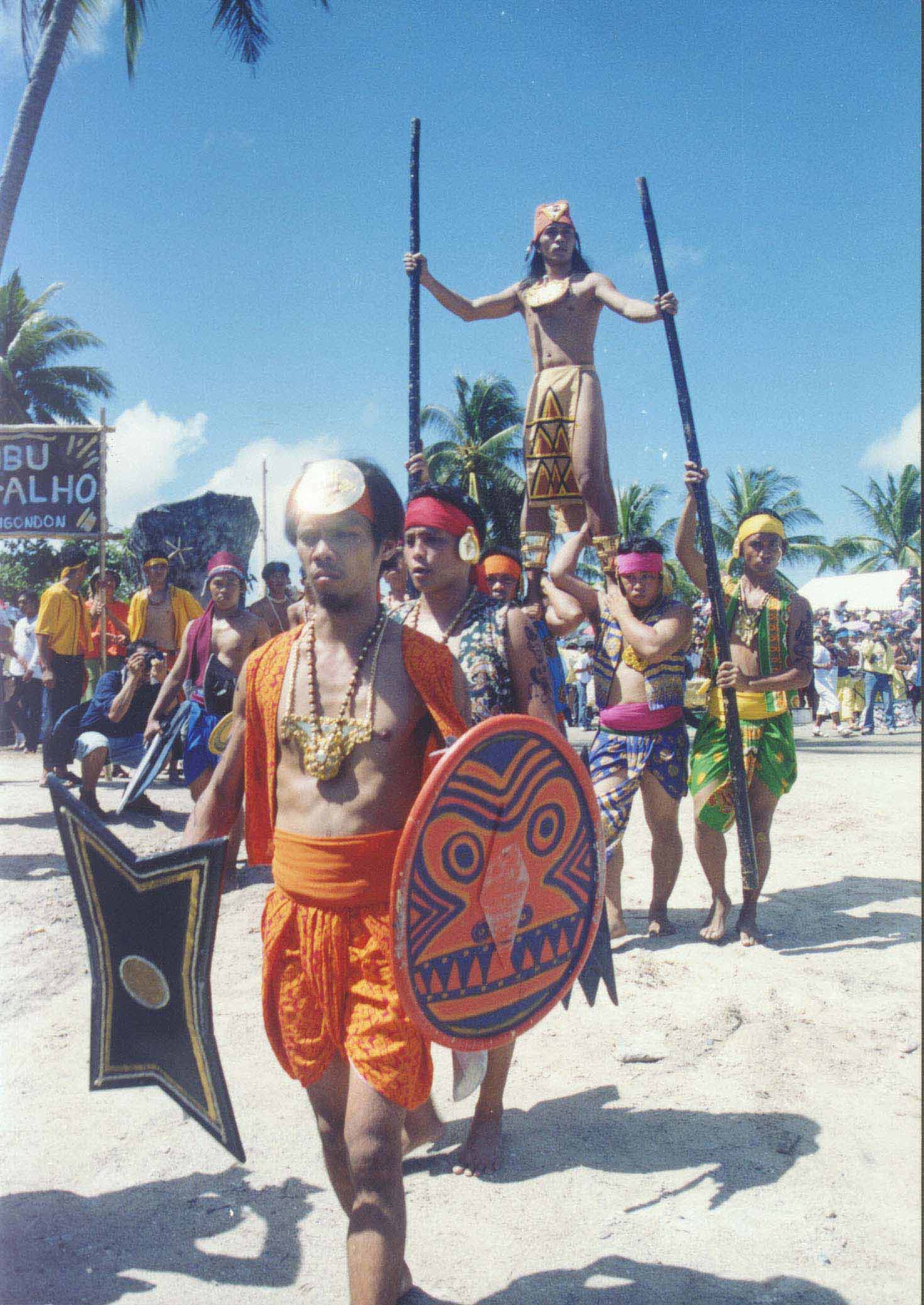 |
|
KADAUGAN SA MACTAN FESTIVAL - Lapulapu City
The “Kadaugan Sa Mactan” is celebrated every 27th day of April. It is a re-enactment of the battle of Mactan on the 16th century. It portrays the fight between the Portuguese explorer, Magellan and the Cebuano native, Lapu-lapu. Lapu-lapu and the Mactan islanders won the battle and successfully drove the Spaniards from the shores of Mactan.
The festival is held in honor of the victory of Lapu-lapu against the foreign ruler Magellan. The annual celebration is one of the tourist attractions in Mactan. It is a full-length musical about the battle of Mactan. Every year, a new presentation is showed but with the same storyline is followed or based. Usually the presentations of the musical are held at the Mactan Shrine at Punta Engano.
|
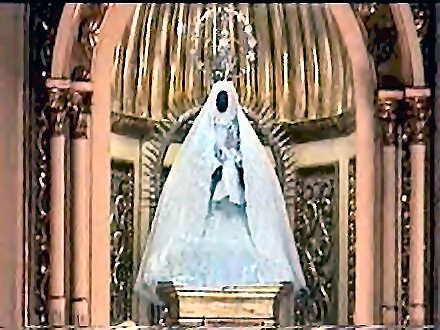 |
|
BIRHEN SA REGLA - Opon
This fiesta was held to honor the patroness of Opon, and the celebrations always take place every year on November 20-21. This religious and social event reveals the deep religious faith of the people and the penchant for merry making. A food fair, a procession and then a coronation of the Fiesta Queen highlights the festivity.
It has been known that Opon was the nickname of Lapu-lapu. As a matter of fact, Lapu-lapu has nothing to do with the original name of the island. Opon, or opong, was a local word which refers to the cogon grass used to teem the island. And thus, the island had derived their name from that lowly cogon grass called opon.
According to history, the first parish to have been created by the Augustinians in mainland Cebu was the San Nicolas Parish, 1584. Opon was a visita of San Nicolas from the early 1600's and up to the start of the 18th century, civily and ecclesiastically under the administration of San Nicolas. The first parish priest of Opon was Fr. Francisco Avalle, an Augustinian friar from Spain who officially began his term in 1735. He was referred to as the "Prior y Ministro del Convento de Nuestra Señora de Opon". The first diocesan priest, after the parish was governed by the Augustinians and then the Jesuits, was Fr. Vicente Roa.
Strictly speaking, the word "regla" does not refer to menstruation. It actually means "rule" or "discipline", as in the Rule of the Order of St. Augustine. It was St. Augustine who hand-carved the first image of the Virgen de Regla and made her the patroness of the Rule of what is the present-day Order of St. Augustine. He made reglas or rules for the members of his Order to follow, dedicating them to the Virgin of St. Augustine.
The dark image of the Virgen de la Regla was due to its history. It was originally the patron saint of North Africa, and so, to give the people a sense of familiarity and acquaintance, their patron saint was also made to have her skin color similar to theirs. What is known in Opon as the Virgen de la Regla was also known to Guadalupe as La Virgen Morena. Whatever her name might be, this patron saint will always continue to bring hope to her people, amidst many trials that they may face.
|
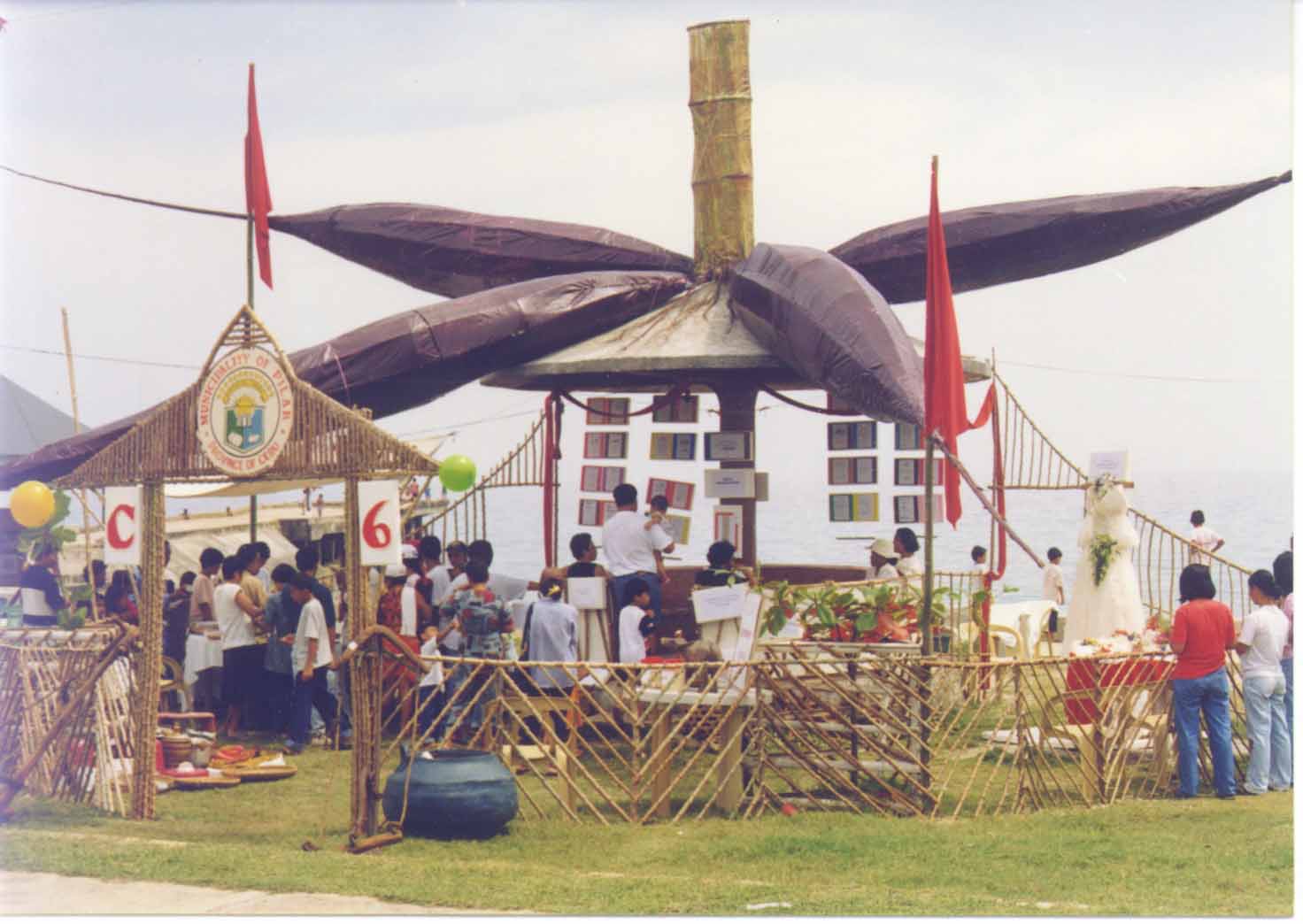 |
|
FESTIVALS OF CAMOTES
Soli-Soli Festival
Every March 18, in San Francisco, Camotes Island, the Soli-soli Festival is celebrated with the town’s patron, St. Joseph the Worker. The festival is named after the soli-soli plant which flourishes around Lake Danao, basically used for weaving mats, hats, baskets and other handicrafts. Costumes and props in freestyle street dancing competition are made of soli-soli grasses as its main material. Though Sinulog-inspired, the street dancing and rituals are based on storylines on the arrival of St. Joseph’s image in San Francisco, the town’s Christianization and the legend of Lake Danao. There are three basic movements in dancing the festivity: 1) “iwagayway” or mimicking the graceful sway of the soli-soli weed, 2) stomping movement that bears a resemblance to harvesting of the weeds, 3) stylized weaving action that reminds everyone of the livelihood that soli-soli has given the locals. Soli-Soli Festival is still two years old.
Tag-anitohan Festival
The whole community participates is a street dancing and ritual contest during the festival. It narrates the history of the town’s origin from immortals to the time of Christianity when the town was separated from its mother town of Poro in 1911, which reflects the importance of culture, traditions and religion given by the natives.
Tudela, a mythical place, was once known as “Tag-anito” which was taken from by the practice of natives worshipping anitos or spirits. The festival also features mascots of native defenders against invading “moro” warriors, the “Mandayang” and which was known for his “anting-anting”. Usually, the street dancing is composed of the general mortal dance, the immortal dance and the great celebration.
Cassava Festival
The Cassava Festival is celebrated during June 10 – 11 annually for a plentiful harvest. This is also a time wherein the farmers parade their various cassava-based products such as cassava cakes, paste and other products. During the festival, varieties of technical experiences in producing and processing cassava-based products are also learned and shared. A lot of activities are participated by the locals such as the Best Booth Contest, Search for New Cassava Food product, Poster Making Contest, Cultural Night and the Search for Miss Camotes Tourism.
Tagbo sa Poro Festival
Tagbo Festival is celebrated during the 18th to the 19th of January in Poro Camotes Island. Tagbo is the foundation of the Poro Municipality. This festival reflects the rich culture heritage and deep religious value that brings a colorful live ceremony celebrating the establishment of Poro town. The main events of the festival are the street dancing and the ‘TAGBO’ dance ritual.
|
|
|
|
|
|
|
|
| |
| |
|
| |
|
|
|

